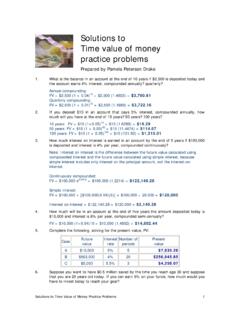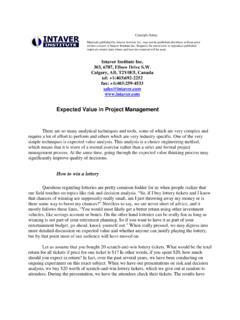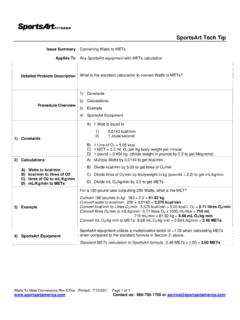Transcription of This PDF is a selection from an out-of-print volume …
1 This PDF is a selection from an out-of-print volume from the NationalBureau of Economic ResearchVolume Title: Monetary Statistics of the United States: Estimates, Sources,MethodsVolume Author/Editor: Milton Friedman and Anna Jacobson SchwartzVolume Publisher: NBERV olume ISBN: 0-870-14210-0 volume URL: Date: 1970 Chapter Title: Part One: Definition of money , IntroductionChapter Author: Milton Friedman, Anna Jacobson SchwartzChapter URL: pages in book: (p. 89 - 92)PART ONEDEFINITION OF MONEYI ntroductionThe four monetary totals in Table 1 are only a selection from a muchlarger number that could be constructed by:furthersubdividingthe items in Table 1(for example, currency into commodity and fidu-ciary currency, or commercial bank deposits into member and non-member bank deposits); grouping the items differently (for example,combining currency and time deposits); or adding other items repre-senting a claim expressed in nominal money value terms (for example,Series E government bonds, brokerage accounts, cash surrender valueof life insurance policies, deposits of policyholders at life insurance com-panies, other federal government securities, local and municipal securi-ties, corporate obligations).
2 Which of these items should be labeled " money ," which "near- money ," which "nonmonetary nominal value liquid assets," and which"nonliquid nominal value assets"?This question has a long background in the literature (Chapter 2),and remains a live issue today, as the continuing discussion in articlesand books answer is bound to be somewhat arbitrary. Hence, it is a tempt-ing approach to try to avoid the question altogether by working onlywith individual assets. However, that is impossible. The separate itemslisted in Table 1 are themselves subtotals. Currency is of different kindsand so is each of the categories of deposits, and the differences amongthe various kinds have at times been of great importance. No subtotalshould be used blindly without regard to the elements of which it iscomposed, but it is impossible to deal only with irreducible elements;there are simply too many of if it were possible to work only with individual assets, it would1 H.
3 A. Latan , "Cash Balances and the Interest Rate A Pragmatic Approach,"Review of Economics and Statistics, Nov. 1954, p. 457; J. G. Gurley and E. S. Shaw,"The Growth of Debt and money in the United States, 1800 1950: A Suggested Inter-pretation," Review of Economics and Statistics, Aug. 1957, p. 250; H. G. Johnson,"Monetary Theory and Policy," American Economic Review, June 1962, pp. 351 352;W. T. Newlyn, Theory of money , New York, 1962, , and "The Supply ofMoney," Economic Journal, June 1964, pp. 327 346; B. P. Pesek and T. R. Saving, money , Wealth, and Economic Theory, New York, 1967, pp. 163 254; Leland B. Yeager,"Essential Properties of the Medium of Exchange," Kyklos, 1968, No. 1, pp. 45 an older discussion of the question, see A. P. Andrew, "What Ought to Be CalledMoney?," Quarterly Journal of Economics, Jan. 1899, pp. 219 227. Andrew approachesthe question in much the same spirit as we do, though his choice of definition differsfrom of Moneybe undesirable to do so.
4 A distinction between " money " and "otherassets" has been found extremely useful for a long time in many con-texts. There is nothing that makes this inevitable. The continuum ofassets might be so gradual and substitution among various types so easyand frequent that no subtotal would have any particular significance shortof, let us say, total nonhuman wealth. It is an empirical generalizationthat this is not the case: there is a subtotal, labeled " money " for con-venience, which it is useful to distinguish because it is related to othereconomic magnitudes in a fairly regular and stable way, though its par-ticular content may be different from place to place or timeto time . Thisempirical generalization underlies the distinction between price theoryand monetary theory a distinction that has been central in economicanalysis for tempting approach is to try to separate " money " from otherassets on the basis of a priori considerations alone.
5 One version, perhapsthe most common, takes as the "essential" function of money its use asa "medium of exchange." It therefore tries to determine which assetsare used to effect transactions and classifies these and only these asmoney. This version tends toward a rather narrow definition of money (Chapter 3, section 1). Another version, which has recently receivedmuch attention, goes to the opposite extreme. Its proponents regard"liquidity" as the essential feature of money and so see little point instopping short of a total that includes almost all assets that are bothexpressed in nominal values and convertible into one another reasonablyquickly and at relatively little financial cost (Chapter 3, section 2).Both the a priori approach and these two specific versions of it seemto us misleading, though highly suggestive (Chapter 3, section 3). Theapproach is misleading because it puts the cart before the horse.
6 Oncewe have a "good" definition, it may turn out that it can be describe4 interms of "medium of exchange" or "liquidity" or some similar generalcharacteristic. The fact that we have a good definition will be evidenceon what the "essential" characteristics of money are; we cannot startfrom the "essential" characteristics and proceed to the definition. Thea priori approach is nonetheless suggestive because it implicitly recordsthe tentative hypotheses derived from earlier studies. These studies sug-gest that it has been found useful to distinguish totals of items that havethe characteristics of serving as a medium of exchange or of providingliquidity. These tentative hypotheses narrow the scope of our further in-Introduction to Part One91vestigation and limit the alternatives thatit seems most fruitful put the matter differently, the economic theory accepted at anytime is in part a systematic summary of the empirical generalizationsthat have been arrived at by students of economic phenomena.
7 Thistheory implicitly contains a specification of the empirical counterpartsto the concepts in terms of which it is expressed otherwise it wouldbe pure mathematics. But the specification may be more or less precise,more or less definite. As the theory is refined and improved, it willgenerally lead to more precise specifications and, conversely, as we findone counterpart or the other to be more useful, it will enable us torefine the theory. It is our judgment that economic theory does not, asyet, give a very precise indication of the appropriate counterpart of theterm " money ." It simply suggests some of the general characteristics ofassets that are likely to be relevant (see Chapter 3, section 1).As these comments imply, the selection of a specific empirical coun-terpart to the term money seems to us to be a matter of convenience fora particular purpose, not a matter of principle.
8 Dogmatism is out ofplace. The selection is to be regarded as an empirical hypothesis assert-ing that a particular definition will be most convenient for a particularpurpose because the magnitude based on that definition bears a moreconsistent and regular relation to other variables relevant for the pur-pose than do alternative magnitudes of the same general class (Chapter3, section 4). It may well be that the specific meaning it is most con-venient to attach to the term money differs for different periods, underdifferent institutional arrangements, or for different purposes. It is cer-tainly highly likely that, as our understanding of the relevant phenomenaincreases, we shall change our views about what definition is most con-venient even for a given period and problem is one that is common in scientific work. A preliminarydecision in this case, on the definition of money must be made.
9 Yetthe decision can be made properly only on the basis of the research inwhich the preliminary decision is to be used. Strictly speaking, the "best"way to define money depends on the conclusions that we reach abouthow various monetary assets are related to one another and to othereconomic variables; yet we need to define " money " to proceed withour research. The solution, also common in scientific work, is of MoneyPrior research and writing narrow down the choice to a limited num-ber of alternatives if " money " is defined to correspond to a total likethose in Table 1. The range of choice is much wider if a more sophisti-cated approach is adopted whereby different degrees of moneyness areattributed to different assets. We have not ourselves adopted this ap-proach though we conjecture that it is probably the most promising forthe future (Chapter 4, section 1).
10 After considering the alternatives in Table 1, we chose to designateas " money " the sum of currency held by the public plus adjusted de-posits of commercial banks, both demand and time (Table 1, column 9).We chose this total in preference to a narrower total including onlydemand deposits largely on the basis of a. historical examination of themeaning of commercial bank demand and time deposits in the UnitedStates and of the factors producing alterations in their relative magni-tude (Chapter 4, section 2). The decision was reinforced by other evi-dence bearing on the comparison between the total we use and bothnarrower and broader totals (Chapter 4, section 3). Further evidencehas since become available from our own work and also the work ofothers. The further evidence partly supports and partly argues againstthe choice we made (Chapter 4, section 4).Though the definition we use seems to us clearly the best single choicefor the period as a whole, its superiority to any of the other totals isslight, and for some specific periods one of the others may be have tried to check many of our results to see whether they dependcritically on the specific definition used.
















